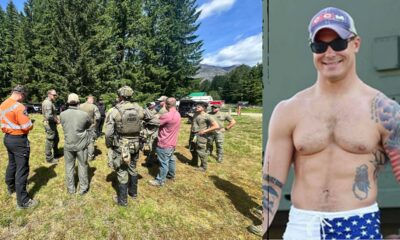West
Democrat Derek Tran unseats Rep. Michelle Steel in California's 45th Congressional District

First-time Democratic candidate and Army veteran Derek Tran has won California’s 45th Congressional District, unseating Trump-endorsed Rep. Michelle Steel in what was considered one of the Golden State’s closely watched races, per The Associated Press.
Tran challenged Steel in what was a traditionally conservative district, although in recent years it has become somewhat of a swing district. The district covers parts of Orange County, including Fountain Valley, Westminster and Garden Grove.
The voting demographic is predominately Asian American.
CALIFORNIA REP IN HEAVILY ASIAN AMERICAN DISTRICT FIGHTS AGAINST CHINESE COMMUNIST INFLUENCE IN EDUCATION
GOP Rep. Michelle Steel, left, and challenger Derek Tran, right (Getty Images)
Steel was first elected to Congress in 2020 in the neighboring 48th District, in which she defeated incumbent Democrat Harley Rhouda, flipping the district red.
In 2018, Democrat Katie Porter flipped the district blue after defeating Republican incumbent Mimi Waters.
Steel reclaimed the seat in 2020 and held onto it in 2022 by a narrow lead, making CA-45 one of the Republican-dominated districts that President Biden won in 2020 by around 6%.
After Tran’s win, Steel said on X that giving back to the U.S. – which “welcomed me with open arms” – “would be part of my future.”
“Because of the opportunities offered by this great country, and God’s great blessings, I was able to go to college, start a family, and build my own American Dream. I embarked on a mission to assist First Generation Americans, stand up to our adversaries, and defend human rights,” Steel wrote.
“The journey to work on behalf of legal immigrants and struggling families took me somewhere I never could have imagined – and for which I will always be grateful — the United States Congress. Everything is God’s will and, like all journeys, this one is ending for a new one to begin. I owe a debt of gratitude to my supporters, my staff, my family, my daughters and especially my husband, Shawn, for standing by me through endless campaigns. To my volunteers, we would never have made it this far without your tireless efforts. And, to the voters, thank you. I will never stop fighting for you.”
The Associated Press contributed to this report.
Read the full article from Here

Wyoming
Activists react after Wyoming high court rules abortion ban unconstitutional

BILLINGS— Activists on both sides praised and criticized the Wyoming Supreme Court’s ruling of abortion bans as unconstitutional on Tuesday in a 4-1 majority.
The ruling marks the end of a four-year legal battle in Wyoming since the state’s 2022 abortion ban went in place with the U.S. Supreme Court’s Dobbs decision, which overturned abortion rights on a federal level.
Watch for the report:
Activists react after Wyoming high court rules abortion ban unconstitutional
The ban was put on hold after Wyoming’s only abortion clinic, Wellspring Health Access in Casper, led a suit against the state.
“I was holding my breath as I opened it and read it. But soon that turned to being rather elated. We couldn’t be more pleased with the opinion,” said Julie Burkhart, the clinic’s president.
Vanessa Willardson
The decision comes after a years-long fight and setbacks, including an arsonist who set the clinic on fire in May of 2022.
“We were set to open that next month, but unfortunately that arson set us back by 11 months. We weren’t able to open that until 2023. It was quite devastating,” said Burkhart.
“I don’t think it’s moral, ethical, appropriate for anyone to tell another person what they can or cannot do with their own body,” she added.
Wellspring Health Access

For a Montana advocacy group, it was a different story.
“I was very disappointed,” said Amy Seymour, president of Yellowstone Valley Christians for Life, an anti-abortion advocacy group.
“These pre-born children who are unique, complete, living, individual human beings from the moment of their conception, they can be protected if Wyoming decides to have a constitutional amendment to that degree,” she added.
Vanessa Willardson

Wyoming state Speaker of the House Chip Neiman, a Republican, echoed Seymour’s sentiments with a written statement.
“Today’s decision is an abomination. Four unelected justices thwarted the will of the people to establish a ‘right’ to kill an innocent baby. Thanks to these justices, Wyoming has some of the most radical abortion laws in America. I will not stand for that, and will continue fighting for innocent unborn babies,” said Neiman.
Wyoming Supreme Court strikes down abortion bans, keeping procedure legal
West
Oregon residents sue Homeland Security after tear gas used on anti-ICE protesters

NEWYou can now listen to Fox News articles!
An affordable housing nonprofit and group of nearby residents filed a lawsuit against the Department of Homeland Security (DHS), asking the court to “preclude” the agency from deploying tear gas and chemical or smoke-related munitions that were affecting nearby homes in Oregon.
The suit comes amid months of clashes between DHS agents and anti-immigration-enforcement groups, including Antifa, outside an Immigration and Customs Enforcement (ICE) facility near Interstate 5, where illegal immigrants have been detained and processed.
The Gray’s Landing houses involved in the suit — which was brought by REACH Community Development and supported by the progressive groups Democracy Forward and Protect Democracy — lies kitty-corner to the ICE facility on the Willamette River.
DHS SHARES ‘VIDEO EVIDENCE’ TO JUSTIFY BORDER PATROL’S TEAR GAS USE DURING CHAOTIC CHICAGO IMMIGRATION RAID
Federal agents clash with protesters outside a downtown U.S. Immigration and Customs Enforcement facility in Portland, Oregon, Oct. 4, 2025. (Spencer Platt/Getty Images)
In the filing, the plaintiffs called DHS’ actions “shocking” and asked the court to ban immigration enforcement agents from using chlorobenzalmalononitrile (CS gas/”tear gas”) and other crowd control tools “unless the use of such munitions is necessary to protect against an imminent and concrete threat to the lives of federal officers or other persons.”
The suit claims officers have deployed pepper balls, CS gas and the like “toward and around” the low-income housing complex “repeatedly when faced with no violence from protesters or imminent risk of harm.”
The nearby residents claimed to have suffered acute respiratory distress, ocular burning sensations and post-traumatic stress disorder episodes due to ICE’s forceful enforcement strategies.
ICE ACCUSES DEM LAWMAKER OF JOINING ‘RIOTING CROWD’ IN ARIZONA, INTERFERING IN MASS ARREST
“The government causing poisonous gas and chemicals to enter plaintiffs’ bodies violates their right to bodily integrity, which the Supreme Court has long recognized as a component of the right to liberty,” the suit claimed.
REACH CEO Margaret Salazar said that as a residential community, Gray’s Landing houses families, senior citizens, veterans and handicapped people who are “repeatedly exposed to chemical agents.”
“Children are coughing indoors, seniors are struggling to breathe, and daily life has become a source of stress and fear.”
TRUMP ADMIN SUES ILLINOIS GOV. PRITZKER OVER LAWS SHIELDING MIGRANTS FROM COURTHOUSE ARRESTS
An anti-ICE demonstrator wearing a keffiyeh is led away by authorities in handcuffs. (TPUSA Frontlines)
Democracy Forward leader Skye Perryman added that chemicals being used by the feds are also discouraging protesters from “using their voices.”
“Federal officers know that poison is flooding apartments where families live, where children sleep, and where seniors and veterans seek safety—and they keep using them anyway, fully aware of the severe harm they cause. There is no legal or moral justification for this use of force–it is a profound abuse of power and violates the U.S. Constitution. We are in court to stop it.”
Daniel Jacobson, an attorney for the plaintiffs, said in a statement the government is “poisoning” residents.
BORDER PATROL CHIEF, PROGRESSIVE MAYOR CAUGHT ON CAMERA IN TENSE STREET SHOWDOWN: ‘EXCELLENT DAY IN EVANSTON’
President Donald Trump previously tried to deploy Oregon National Guard troops to quell springtime unrest in Portland, while Oregon sits among the top five states with the largest year-to-year increase in ICE arrests according to the Salem Reporter.
More than 660 people have been arrested by the feds there in 2025.
After Trump indicated during the summer that DHS would be asked to focus on certain problem areas of the country, Oregon Gov. Tina Kotek remarked, “I don’t take kindly to the fact that the federal administration is picking on particular cities.”
DHS TORCHES ‘BAMBOOZLED’ DEMS FOR CALLING ICE CRACKDOWN ‘VICIOUS LIES’
In November, Sen. Jeffrey Merkley, D-Ore., slammed the administration for “disturbing” raids he said are “terrorizing our communities” and allegedly detaining people “solely” based on race.
“Trump is using ICE to stoke fear and uncertainty in our communities, shredding our Constitution in the process,” Merkley claimed.
Rep. Suzanne Bonamici, another Oregon Democrat representing Tillamook and part of Portland, led a letter to DHS Secretary Kristi Noem demanding information on the types of irritants and munitions being used against protesters.
CLICK HERE TO DOWNLOAD THE FOX NEWS APP
“More than a dozen advocates outside the facility have reported unprovoked attacks by Homeland Security police and FPS officers,” she claimed in the October missive, which was also signed by Merkley, Sen. Ron Wyden, and Rep. Maxine Dexter.
Fox News Digital reached out to the DHS for comment. While the agency did not directly respond for comment, Secretary Kristi Noem said in a recent statement that she will seek prosecution for all who doxx ICE agents.
“These criminals are taking the side of vicious cartels and human traffickers. We won’t allow it in America,” she said, as the agency appeared to defend its use-of-force tactics, citing the Portland facility being “under siege” for some time.
“Rioters have attacked law enforcement officials, destroyed federal property, and have posted death threats at the facility. Outside of the facility, graffiti on the sidewalk reads ‘Kill Your Masters’,” the agency said in a July statement.
“Across the country, federal law enforcement has come under attack. Gunmen opened fire on Border Patrol and ICE officers in Texas over the Fourth of July weekend on two separate occasions, seriously wounding two,” the statement added.
Read the full article from Here
San Francisco, CA
Downtown San Francisco Immigration Court Set to Close In a Year

The federal immigration court in downtown San Francisco that started 2025 with 21 judges and will soon be down to just four, thanks to Trump administration mass-firings, will close by January 2027.
News arrived Wednesday that federal officials are planning to shut down the immigration court at 100 Montgomery Street in San Francisco by the end of the year, and transfer all or most immigration court activity to the court in Concord. Mission Local reported the news via a source close to the situation, and KTVU subsequently confirmed the move.
Jeremiah Johnson, one of the SF judges who was fired this past year, serves as vice president of the National Association of Immigration Judges, and confirmed the news to KTVU.
The Executive Office for Immigration Review, which oversees immigration court operations, has yet to comment.
As Mission Local reports, a smaller set of courtrooms at the other SF immigration facility and ICE headquarters at 630 Sansome Street will remain open for business.
The Concord immigration court saw five judge fired last year, though two had not yet begun hearing any cases. Seven judges remain at that court, and four remaining judges based at 100 Montgomery are expected to be transferred there by this summer.
Mission Local previously reported that out of 21 judges serving at the courthouse last spring, 13 have been fired in recent months, and four others are scheduled for retirement by the end of this month.
This is happening as the court has a backlog of some 120,000 pending cases.
As Politico reported last month, the Trump administration has fired around 98 immigration judges out of the 700 who had been serving as of early last year.
Olivia Cassin, a fired judge based in New York, said this was by design, and, “It’s about destroying a system where cases are carefully considered by people with knowledge of the subject matter.”
This is all perfectly legal, as Politico explained, because immigration judges serve in administrative courts as at-will employees, under the purview of the Department of Justice — and do not have the same protections as the federal judiciary bench.
A spokesperson for the DOJ has said that the department is “restoring integrity to our immigration system and encourages talented legal professionals to join in our mission to protect national security and public safety,” following “four years of the Biden Administration forcing Immigration Courts to implement a de facto amnesty for hundreds of thousands of aliens.”
Johnson also spoke to Politico suggesting that this recruitment language by the DOJ is disingenuous, and that the real intention is just to cripple the entire court system and prevent most legal immigration cases from being heard.
“During Trump One, when I was appointed, there was a policy that got some pushback called ‘No Dark Courtrooms.’ We were to hear cases every day, use all the [available] space,” Johnson said, speaking to Politico. “Now, there’s vacant courtrooms that are not being utilized. And any attempts by the administration saying they’re replacing judges — the math just doesn’t work if you look at the numbers.”
Two Democrats in the House, Reps. Dan Goldman of New York and Zoe Lofgren of California, have recently introduced legislation that would move immigration courts out of the Executive branch, but that seems likely to go nowhere until Democrats regain control in Congress.
-

 News1 week ago
News1 week agoFor those who help the poor, 2025 goes down as a year of chaos
-

 Detroit, MI4 days ago
Detroit, MI4 days ago2 hospitalized after shooting on Lodge Freeway in Detroit
-
Georgia1 week ago
Best in Georgia: 2025 AJC Varsity high school football all-state teams
-

 Dallas, TX3 days ago
Dallas, TX3 days agoDefensive coordinator candidates who could improve Cowboys’ brutal secondary in 2026
-

 Detroit, MI1 week ago
Detroit, MI1 week agoWith 46k outages around Michigan, Metro Detroit prepares for power loss
-

 Southeast1 week ago
Southeast1 week agoMurder in small-town America: The crimes that tore quiet communities apart in 2025
-

 Miami, FL1 week ago
Miami, FL1 week agoMiami-Dade sheriff’s deputy opens fire on vehicle after altercation during traffic stop, officials say
-

 Midwest1 week ago
Midwest1 week agoMcDonald’s locks doors to keep out individuals who present ‘a risk’ in crime-ridden Minneapolis area











